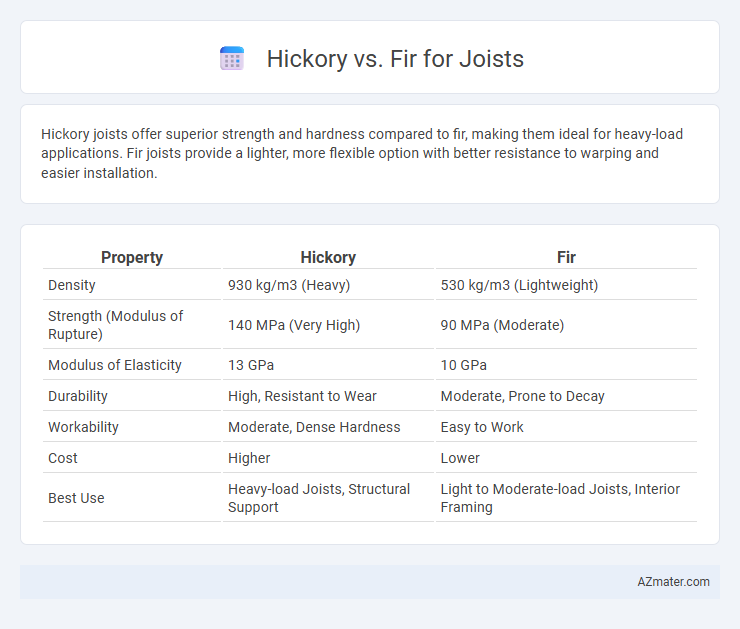Hickory joists offer superior strength and hardness compared to fir, making them ideal for heavy-load applications. Fir joists provide a lighter, more flexible option with better resistance to warping and easier installation.
Table of Comparison
| Property | Hickory | Fir |
|---|---|---|
| Density | 930 kg/m3 (Heavy) | 530 kg/m3 (Lightweight) |
| Strength (Modulus of Rupture) | 140 MPa (Very High) | 90 MPa (Moderate) |
| Modulus of Elasticity | 13 GPa | 10 GPa |
| Durability | High, Resistant to Wear | Moderate, Prone to Decay |
| Workability | Moderate, Dense Hardness | Easy to Work |
| Cost | Higher | Lower |
| Best Use | Heavy-load Joists, Structural Support | Light to Moderate-load Joists, Interior Framing |
Introduction to Hickory and Fir for Joists
Hickory and fir are two popular wood choices for joists, each offering distinct structural benefits. Hickory is known for its exceptional hardness, strength, and shock resistance, making it ideal for heavy loads and high-stress applications. Fir, particularly Douglas fir, provides a balanced combination of strength, stiffness, and stability, often used in construction due to its consistent grain and ease of workability.
Wood Strength and Load-Bearing Capacity
Hickory joists exhibit superior wood strength and load-bearing capacity compared to fir, making them ideal for heavy structural applications. With a higher Janka hardness rating of 1,820 psi, hickory offers increased resistance to denting and deformation, sustaining greater loads without compromising stability. Fir, while lighter and easier to work with, provides a lower moduli of elasticity and bending strength, limiting its performance in high-stress joist installations.
Durability and Longevity Comparison
Hickory joists exhibit superior durability due to their high density and hardness, making them highly resistant to wear and impact damage. Fir joists, while less dense, provide reliable longevity with natural resistance to decay and moderate strength, suitable for indoor structural applications. Hickory's exceptional toughness ensures extended lifespan in high-stress environments, whereas fir offers cost-effective durability for standard construction uses.
Cost Differences Between Hickory and Fir
Hickory joists generally cost more than fir due to their higher density and superior hardness, which contributes to increased material and processing expenses. Fir offers a more economical option with adequate strength and durability for most joist applications, making it a popular choice in cost-sensitive projects. The price difference can influence budget decisions, with hickory preferred when enhanced load-bearing capacity justifies the added investment.
Workability and Ease of Installation
Hickory joists offer superior hardness and durability but can be challenging to work with due to their density, requiring specialized tools for cutting and fastening, which may slow installation. Fir joists are lighter and have a more uniform grain, making them easier to saw, nail, and handle on-site, resulting in faster installation times and less labor fatigue. Overall, fir joists provide better workability and ease of installation, especially for projects where speed and tool compatibility are priorities.
Resistance to Moisture and Decay
Hickory offers superior resistance to moisture and decay compared to fir, making it a more durable choice for joists in humid or wet environments. Fir, while popular for its affordability and ease of use, is more susceptible to moisture absorption and fungal decay without proper treatment. Choosing hickory joists can extend structural longevity and reduce maintenance needs in moisture-prone areas.
Environmental Impact and Sustainability
Hickory joists offer greater sustainability due to their slower growth rate and higher density, which increases durability and reduces the frequency of replacement. Fir joists, primarily sourced from fast-growing Douglas fir species, support sustainable forestry practices by promoting efficient reforestation and carbon sequestration. Both woods can be sourced from certified sustainable forests, but fir's rapid renewability often results in a lower overall environmental footprint compared to hickory.
Weight and Transportation Considerations
Hickory joists are significantly heavier than fir, impacting transportation costs and handling ease during construction. Fir's lighter weight makes it more cost-effective for shipping and simpler to maneuver on-site, especially for large-scale projects. Weight differences influence equipment requirements and labor intensity, with hickory demanding stronger support and more effort for installation compared to fir.
Availability and Sourcing of Each Wood
Hickory joists are less commonly available and often sourced from select hardwood suppliers due to their dense, durable nature and limited regional growth primarily in the eastern United States. Fir joists, particularly Douglas Fir, enjoy widespread availability from large-scale lumber distributors and mills, benefiting from fast growth and extensive forestry management across North America. Fir's consistent supply and regional sustainability make it a more accessible choice for construction projects requiring reliable joist materials.
Best Applications for Hickory vs Fir Joists
Hickory joists excel in high-load applications due to their exceptional hardness and strength, making them ideal for heavy structural framing and flooring where durability is critical. Fir joists, known for their dimensional stability and lighter weight, are best suited for residential construction and interior framing that requires ease of installation and resistance to warping. Selecting hickory joists enhances longevity in demanding environments, while fir joists optimize cost-effectiveness and structural reliability in standard building projects.

Infographic: Hickory vs Fir for Joist
 azmater.com
azmater.com